 W
WThe Bauer Automatic is an American-made copy of the Baby Browning. Made of stainless steel, they are chambered in .25 ACP with a six-round magazine capacity. The Bauer was manufactured in Fraser, Michigan from 1972–1984. The pistol was marketed as the Fraser-25 from 1984 to 1986.
 W
WThe Beretta 21A Bobcat is a semi-automatic pocket pistol designed by Beretta in Italy. Production began in late 1984, solely in the Beretta U.S.A. facility in Accokeek, Maryland. It is a further development of the Beretta Model 20, whose production ended in 1985.
The Beretta M418 is an easily-concealed Italian 6.35 mm pocket pistol. The earliest examples were made between 1919 and 1922. There are several versions, including the 1920, 1926, 1926 - 31, 1934, 318, and 418 models.
 W
WThe Beretta 950 is a semi-automatic pistol designed and manufactured by Beretta since 1952. It builds on a long line of small and compact pocket pistols manufactured by Beretta for self-defense. It was intended to be a very simple and reliable pocket pistol.
 W
WThe Model 1908 Vest Pocket is a compact, hammerless, striker-fired, semi-automatic single-action pistol. Manufactured by the Colt's Manufacturing Company from 1908 to 1948, it was marketed as a small concealable firearm which could be easily tucked into a vest pocket for unobtrusive carry. Designed by John Moses Browning, the Model 1908 followed Browning’s earlier European version, introduced by Fabrique Nationale de Herstal as the FN Model 1906. Both pistols were chambered for the Browning-invented .25 ACP cartridge.
 W
WThe Vzor 45, commonly known as CZ 45 is a compact blowback operated semi-automatic pistol chambered in .25 ACP. It was made in Czechoslovakia and later in the Czech Republic. Derived from the CZ-36 following World War II, the CZ-45 is currently manufactured by Česká zbrojovka Uherský Brod as the CZ-92.
 W
WThe 1931 Fabrique Nationale (FN) Baby Browning is a small blowback-operated semi-automatic pistol designed by Belgium-born Dieudonné Saive chambered in .25 ACP. The pistol features a six-round magazine capacity and is a striker-fired, single action, blow back mechanism. The manual thumb operated safety locks the slide in the closed position when engaged using side thumb pressure.
 W
WThe HK 4 pocket pistol was first introduced by Heckler & Koch in 1967. Government agencies received 12,000 pistols in the .32 ACP caliber with the designation P11 and were serial numbered 40001 to 52400.
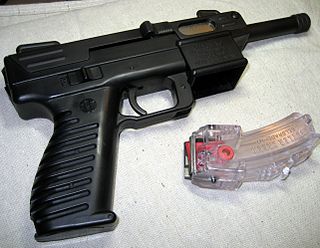 W
WThe Intratec TEC-22 is a semi-automatic handgun chambered in .22 Long Rifle. It was also marketed as the Scorpion and Sport-22. The TEC-22 operates using a straight blow-back action.
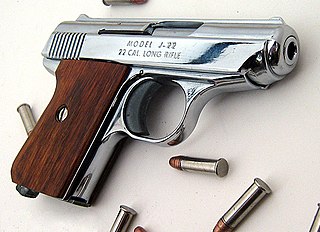 W
WThe Jimenez JA-22 is an .22 LR caliber pistol with Zamak, a zinc alloy, slide and frame. A version chambered in .25 ACP, called the JA-25, is also available. It was introduced by Jennings Firearms as the Jennings J-22 in the 1970s. Bryco Arms, Jennings' parent company, declared bankruptcy in 2003, and was subsequently purchased by the company's former foreman Paul Jimenez. After renaming the company Jimenez Arms, the J-22 and J-25 were renamed the JA-22 and JA-25 respectively.
 W
WThe JO.LO.AR. was a semi-automatic pistol of Spanish origin and is chambered in various calibres. It is a development of the Extractor Model Sharpshooter pistol and was manufactured from 1924 by Bonifacio Echeveria STAR, with patent by J. Lopez de Arnaiz and renamed the JO-LO-AR, hence the designer's initials.
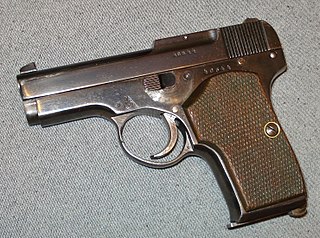 W
WThe Korovin pistol is regarded as the first Soviet semi-automatic pistol.
 W
WThe Le Français pistol by Manufrance was produced from 1913 till 1969, in a variety of calibres. It was mainly sold in France, primarily to the greater public but also to some officers of the French Army, and to the French municipal police. In 1912, Etienne Mimard the Head of Manufrance started development. Mr. Mimard obtained the patent for the first model on August 6, 1913 with n° 472.505. Sales started in 1914 with the name "Le Français".
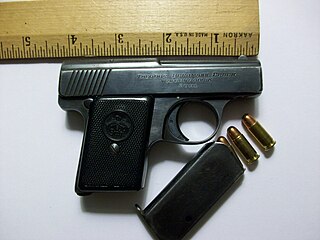 W
WThe 4.25 mm Liliput pistol is one of the smallest semiautomatic handguns ever made. Hence its name, derived from the fictional island of Lilliput, inhabited by tiny people.
 W
WThe MAB Model A is a 6.35 mm caliber pocket pistol made in France. MAB stands for Manufacture d'armes de Bayonne. It is patterned after the Browning FN 1906 / Colt Model 1908.
 W
WThe Mauser Model 1914 is a semi-automatic pistol made by Mauser. A derivative of the .25 caliber Model 1910 designed by Josef Nickl, it uses 32 ACP ammunition.
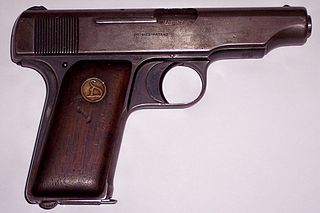 W
WThe Ortgies 7.65 mm pistol was a hammerless semi-automatic pistol produced in Germany in the years immediately after World War I, first by its inventor Heinrich Ortgies and then by Deutsche Werke. Inexpensive, but of good quality, the pistol achieved considerable success at contemporary shooting competitions and, as an export product, was popular throughout the Americas.
 W
WThe Sauer 38H or often just H was a small semi-automatic pistol made in Nazi Germany from 1938 until just after the end of World War II by J. P. Sauer & Sohn, then based in Suhl, Germany. The "H" in the model number is short for "hahn", referring to the internal hammer of the firing mechanism.
 W
WThe Tanfoglio GT27 is a .25 ACP caliber, blow-back operated, single-action, 7 round magazine fed single action handgun manufactured in Italy by Tanfoglio. It is similar to the Beretta 950 Jetfire in that it has an open slide.
 W
WThe Walther Model 9 was a striker fired semi-automatic pistol produced by Walther arms and chambered in .25 ACP. The decision to use a striker vs. that of an internal hammer like on the Walther Model 8 was to reduce overall size of the gun, but sacrificed reliability. If the striker spring is compressed for extended periods of time it can weaken and not have enough force to ignite the primer causing a miss-fire. This can be avoided by not keeping the pistol cocked when not in use. It has a 6 round detachable box magazine. The Model 9 is similar in size and function to the Baby Browning pistol which is only slightly larger. The Browning is also chambered in the .25 ACP cartridge.
 W
WThe Walther TP and TPH handguns are extremely compact double-action lightweight semi-automatic pistols in .22 Long Rifle and .25 ACP calibers. Pistols in this size range are sometimes referred to as pocket pistols, or Taschen Pistolen in German. The TP was produced by Walther from 1961-1971 and the improved TPH has been produced continuously since 1968. Models have been produced in Germany and in the US.
 W
WThe Zastava P25, nicknamed the Dark Lady, is a blowback-operated, single-action, semi-automatic pocket pistol chambered in .25 ACP. The P25 is manufactured by Zastava Arms of Serbia. It features a two-stage safety mechanism whereas pulling the hammer into the first position blocks both the trigger and the hammer. The pistol frame is made of aluminum alloy and the barrel is made of alloy steel, while the handgrips are usually made of walnut or polymer materials. The P25 is aimed extensively at the civilian market as a self-defense weapon due to its concealability, but is somewhat less favorable compared to the M57, M88 and CZ 99 pistols due to its small caliber.